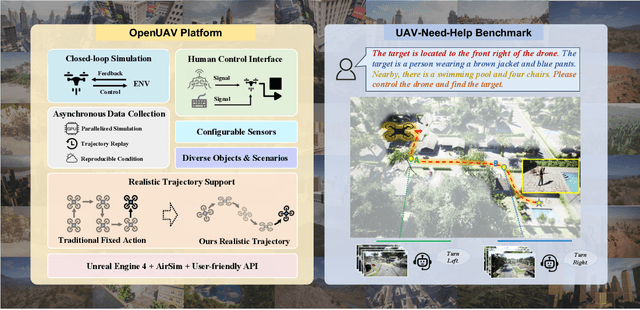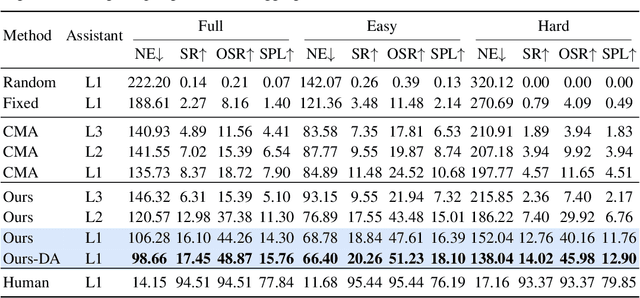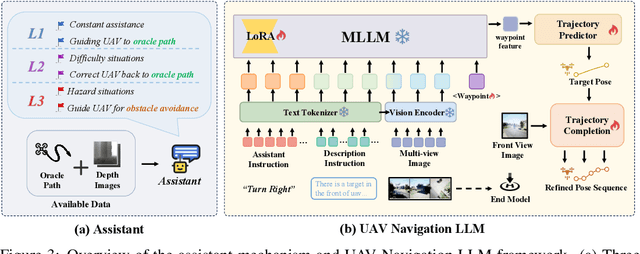Xiangyu Wang
School of Artificial Intelligence, Nanjing University
Generative Evaluation of Complex Reasoning in Large Language Models
Apr 03, 2025Abstract:With powerful large language models (LLMs) demonstrating superhuman reasoning capabilities, a critical question arises: Do LLMs genuinely reason, or do they merely recall answers from their extensive, web-scraped training datasets? Publicly released benchmarks inevitably become contaminated once incorporated into subsequent LLM training sets, undermining their reliability as faithful assessments. To address this, we introduce KUMO, a generative evaluation framework designed specifically for assessing reasoning in LLMs. KUMO synergistically combines LLMs with symbolic engines to dynamically produce diverse, multi-turn reasoning tasks that are partially observable and adjustable in difficulty. Through an automated pipeline, KUMO continuously generates novel tasks across open-ended domains, compelling models to demonstrate genuine generalization rather than memorization. We evaluated 23 state-of-the-art LLMs on 5,000 tasks across 100 domains created by KUMO, benchmarking their reasoning abilities against university students. Our findings reveal that many LLMs have outperformed university-level performance on easy reasoning tasks, and reasoning-scaled LLMs reach university-level performance on complex reasoning challenges. Moreover, LLM performance on KUMO tasks correlates strongly with results on newly released real-world reasoning benchmarks, underscoring KUMO's value as a robust, enduring assessment tool for genuine LLM reasoning capabilities.
Glioma Multimodal MRI Analysis System for Tumor Layered Diagnosis via Multi-task Semi-supervised Learning
Jan 29, 2025



Abstract:Gliomas are the most common primary tumors of the central nervous system. Multimodal MRI is widely used for the preliminary screening of gliomas and plays a crucial role in auxiliary diagnosis, therapeutic efficacy, and prognostic evaluation. Currently, the computer-aided diagnostic studies of gliomas using MRI have focused on independent analysis events such as tumor segmentation, grading, and radiogenomic classification, without studying inter-dependencies among these events. In this study, we propose a Glioma Multimodal MRI Analysis System (GMMAS) that utilizes a deep learning network for processing multiple events simultaneously, leveraging their inter-dependencies through an uncertainty-based multi-task learning architecture and synchronously outputting tumor region segmentation, glioma histological subtype, IDH mutation genotype, and 1p/19q chromosome disorder status. Compared with the reported single-task analysis models, GMMAS improves the precision across tumor layered diagnostic tasks. Additionally, we have employed a two-stage semi-supervised learning method, enhancing model performance by fully exploiting both labeled and unlabeled MRI samples. Further, by utilizing an adaptation module based on knowledge self-distillation and contrastive learning for cross-modal feature extraction, GMMAS exhibited robustness in situations of modality absence and revealed the differing significance of each MRI modal. Finally, based on the analysis outputs of the GMMAS, we created a visual and user-friendly platform for doctors and patients, introducing GMMAS-GPT to generate personalized prognosis evaluations and suggestions.
MTMT: Consolidating Multiple Thinking Modes to Form a Thought Tree for Strengthening LLM
Dec 05, 2024Abstract:Large language models (LLMs) have shown limitations in tasks requiring complex logical reasoning and multi-step problem-solving. To address these challenges, researchers have employed carefully designed prompts and flowcharts, simulating human cognitive processes to enhance LLM performance, such as the Chain of Thought approach. In this paper, we introduce MTMT (Multi-thinking Modes Tree), a novel method that interacts with LLMs to construct a thought tree, simulating various advanced cognitive processes, including but not limited to association, counterfactual thinking, task decomposition, and comparison. By breaking down the original complex task into simpler sub-questions, MTMT facilitates easier problem-solving for LLMs, enabling more effective utilization of the latent knowledge within LLMs. We evaluate the performance of MTMT under different parameter configurations, using GPT-4o mini as the base model. Our results demonstrate that integrating multiple modes of thinking significantly enhances the ability of LLMs to handle complex tasks.
Towards Realistic UAV Vision-Language Navigation: Platform, Benchmark, and Methodology
Oct 10, 2024



Abstract:Developing agents capable of navigating to a target location based on language instructions and visual information, known as vision-language navigation (VLN), has attracted widespread interest. Most research has focused on ground-based agents, while UAV-based VLN remains relatively underexplored. Recent efforts in UAV vision-language navigation predominantly adopt ground-based VLN settings, relying on predefined discrete action spaces and neglecting the inherent disparities in agent movement dynamics and the complexity of navigation tasks between ground and aerial environments. To address these disparities and challenges, we propose solutions from three perspectives: platform, benchmark, and methodology. To enable realistic UAV trajectory simulation in VLN tasks, we propose the OpenUAV platform, which features diverse environments, realistic flight control, and extensive algorithmic support. We further construct a target-oriented VLN dataset consisting of approximately 12k trajectories on this platform, serving as the first dataset specifically designed for realistic UAV VLN tasks. To tackle the challenges posed by complex aerial environments, we propose an assistant-guided UAV object search benchmark called UAV-Need-Help, which provides varying levels of guidance information to help UAVs better accomplish realistic VLN tasks. We also propose a UAV navigation LLM that, given multi-view images, task descriptions, and assistant instructions, leverages the multimodal understanding capabilities of the MLLM to jointly process visual and textual information, and performs hierarchical trajectory generation. The evaluation results of our method significantly outperform the baseline models, while there remains a considerable gap between our results and those achieved by human operators, underscoring the challenge presented by the UAV-Need-Help task.
Real-time Detection and Auto focusing of Beam Profiles from Silicon Photonics Gratings using YOLO model
Sep 22, 2024



Abstract:When observing the chip-to-free-space light beams from silicon photonics (SiPh) to free-space, manual adjustment of camera lens is often required to obtain a focused image of the light beams. In this letter, we demonstrated an auto-focusing system based on you-only-look-once (YOLO) model. The trained YOLO model exhibits high classification accuracy of 99.7% and high confidence level >0.95 when detecting light beams from SiPh gratings. A video demonstration of real-time light beam detection, real-time computation of beam width, and auto focusing of light beams are also included.
AdaptiveFusion: Adaptive Multi-Modal Multi-View Fusion for 3D Human Body Reconstruction
Sep 07, 2024



Abstract:Recent advancements in sensor technology and deep learning have led to significant progress in 3D human body reconstruction. However, most existing approaches rely on data from a specific sensor, which can be unreliable due to the inherent limitations of individual sensing modalities. On the other hand, existing multi-modal fusion methods generally require customized designs based on the specific sensor combinations or setups, which limits the flexibility and generality of these methods. Furthermore, conventional point-image projection-based and Transformer-based fusion networks are susceptible to the influence of noisy modalities and sensor poses. To address these limitations and achieve robust 3D human body reconstruction in various conditions, we propose AdaptiveFusion, a generic adaptive multi-modal multi-view fusion framework that can effectively incorporate arbitrary combinations of uncalibrated sensor inputs. By treating different modalities from various viewpoints as equal tokens, and our handcrafted modality sampling module by leveraging the inherent flexibility of Transformer models, AdaptiveFusion is able to cope with arbitrary numbers of inputs and accommodate noisy modalities with only a single training network. Extensive experiments on large-scale human datasets demonstrate the effectiveness of AdaptiveFusion in achieving high-quality 3D human body reconstruction in various environments. In addition, our method achieves superior accuracy compared to state-of-the-art fusion methods.
Recognizing Beam Profiles from Silicon Photonics Gratings using Transformer Model
Aug 22, 2024Abstract:Over the past decade, there has been extensive work in developing integrated silicon photonics (SiPh) gratings for the optical addressing of trapped ion qubits in the ion trap quantum computing community. However, when viewing beam profiles from infrared (IR) cameras, it is often difficult to determine the corresponding heights where the beam profiles are located. In this work, we developed transformer models to recognize the corresponding height categories of beam profiles of light from SiPh gratings. The model is trained using two techniques: (1) input patches, and (2) input sequence. For model trained with input patches, the model achieved recognition accuracy of 0.938. Meanwhile, model trained with input sequence shows lower accuracy of 0.895. However, when repeating the model-training 150 cycles, model trained with input patches shows inconsistent accuracy ranges between 0.445 to 0.959, while model trained with input sequence exhibit higher accuracy values between 0.789 to 0.936. The obtained outcomes can be expanded to various applications, including auto-focusing of light beam and auto-adjustment of z-axis stage to acquire desired beam profiles.
A Unified Framework for Combinatorial Optimization Based on Graph Neural Networks
Jun 19, 2024Abstract:Graph neural networks (GNNs) have emerged as a powerful tool for solving combinatorial optimization problems (COPs), exhibiting state-of-the-art performance in both graph-structured and non-graph-structured domains. However, existing approaches lack a unified framework capable of addressing a wide range of COPs. After presenting a summary of representative COPs and a brief review of recent advancements in GNNs for solving COPs, this paper proposes a unified framework for solving COPs based on GNNs, including graph representation of COPs, equivalent conversion of non-graph structured COPs to graph-structured COPs, graph decomposition, and graph simplification. The proposed framework leverages the ability of GNNs to effectively capture the relational information and extract features from the graph representation of COPs, offering a generic solution to COPs that can address the limitations of state-of-the-art in solving non-graph-structured and highly complex graph-structured COPs.
Async Learned User Embeddings for Ads Delivery Optimization
Jun 09, 2024



Abstract:User representation is crucial for recommendation systems as it helps to deliver personalized recommendations by capturing user preferences and behaviors in low-dimensional vectors. High-quality user embeddings can capture subtle preferences, enable precise similarity calculations, and adapt to changing preferences over time to maintain relevance. The effectiveness of recommendation systems depends significantly on the quality of user embedding. We propose to asynchronously learn high fidelity user embeddings for billions of users each day from sequence based multimodal user activities in Meta platforms through a Transformer-like large scale feature learning module. The async learned user representations embeddings (ALURE) are further converted to user similarity graphs through graph learning and then combined with user realtime activities to retrieval highly related ads candidates for the entire ads delivery system. Our method shows significant gains in both offline and online experiments.
Confidence-aware Contrastive Learning for Selective Classification
Jun 07, 2024Abstract:Selective classification enables models to make predictions only when they are sufficiently confident, aiming to enhance safety and reliability, which is important in high-stakes scenarios. Previous methods mainly use deep neural networks and focus on modifying the architecture of classification layers to enable the model to estimate the confidence of its prediction. This work provides a generalization bound for selective classification, disclosing that optimizing feature layers helps improve the performance of selective classification. Inspired by this theory, we propose to explicitly improve the selective classification model at the feature level for the first time, leading to a novel Confidence-aware Contrastive Learning method for Selective Classification, CCL-SC, which similarizes the features of homogeneous instances and differentiates the features of heterogeneous instances, with the strength controlled by the model's confidence. The experimental results on typical datasets, i.e., CIFAR-10, CIFAR-100, CelebA, and ImageNet, show that CCL-SC achieves significantly lower selective risk than state-of-the-art methods, across almost all coverage degrees. Moreover, it can be combined with existing methods to bring further improvement.
 Add to Chrome
Add to Chrome Add to Firefox
Add to Firefox Add to Edge
Add to Edge